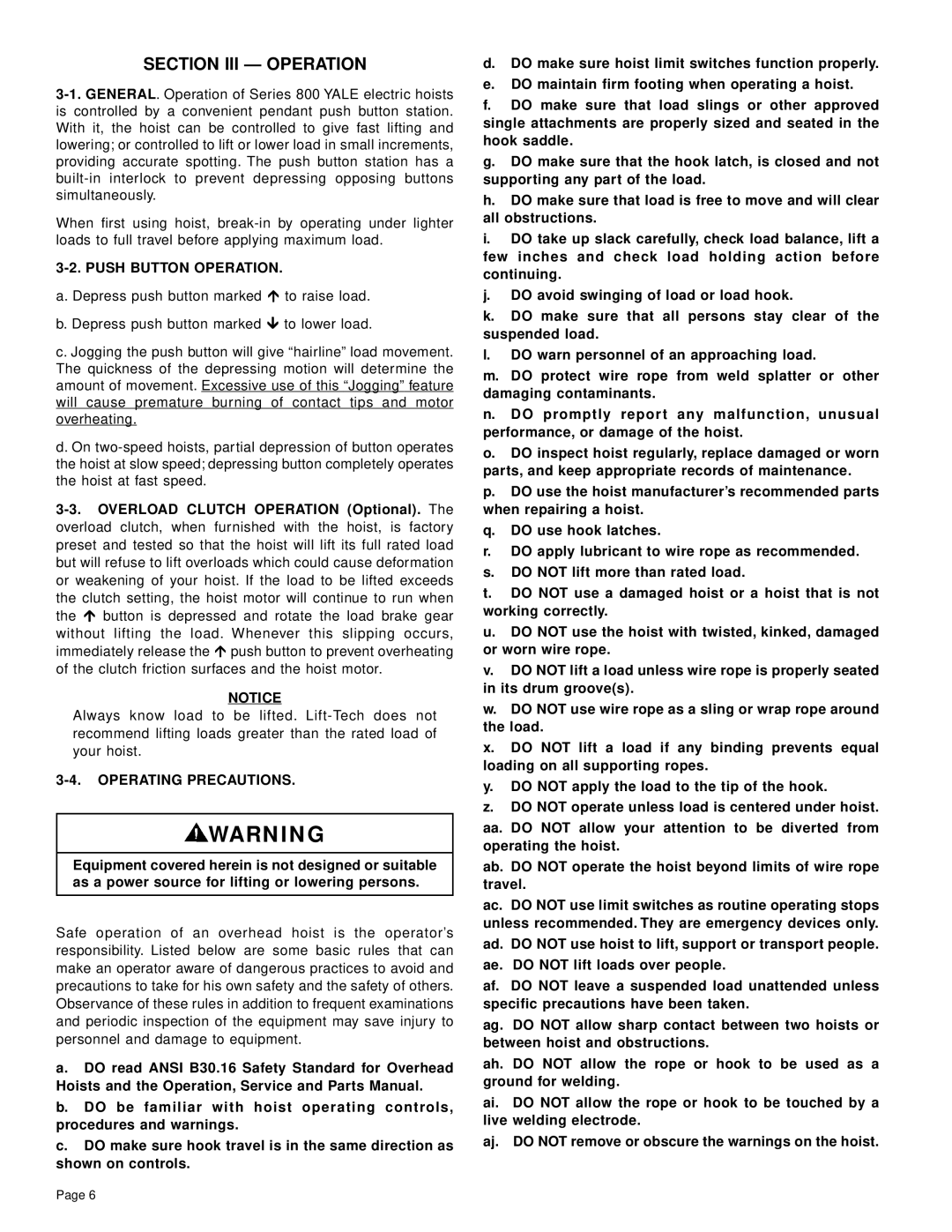
SECTION III — OPERATION
When first using hoist,
3-2. PUSH BUTTON OPERATION.
a. Depress push button marked á to raise load.
b. Depress push button marked â to lower load.
c. Jogging the push button will give “hairline” load movement. The quickness of the depressing motion will determine the amount of movement. Excessive use of this “Jogging”feature will cause premature burning of contact tips and motor overheating.
d. On
3-3. OVERLOAD CLUTCH OPERATION (Optional). The
overload clutch, when furnished with the hoist, is factory preset and tested so that the hoist will lift its full rated load but will refuse to lift overloads which could cause deformation or weakening of your hoist. If the load to be lifted exceeds the clutch setting, the hoist motor will continue to run when the á button is depressed and rotate the load brake gear without lifting the load. Whenever this slipping occurs, immediately release the á push button to prevent overheating of the clutch friction surfaces and the hoist motor.
NOTICE
Always know load to be lifted.
3-4. OPERATING PRECAUTIONS.
![]() WARNING
WARNING
Equipment covered herein is not designed or suitable as a power source for lifting or lowering persons.
Safe operation of an overhead hoist is the operator’s responsibility. Listed below are some basic rules that can make an operator aware of dangerous practices to avoid and precautions to take for his own safety and the safety of others. Observance of these rules in addition to frequent examinations and periodic inspection of the equipment may save injury to personnel and damage to equipment.
a.DO read ANSI B30.16 Safety Standard for Overhead Hoists and the Operation, Service and Parts Manual.
b.DO be familiar with hoist operating controls, procedures and warnings.
c.DO make sure hook travel is in the same direction as shown on controls.
d.DO make sure hoist limit switches function properly.
e.DO maintain firm footing when operating a hoist.
f.DO make sure that load slings or other approved single attachments are properly sized and seated in the hook saddle.
g.DO make sure that the hook latch, is closed and not supporting any part of the load.
h.DO make sure that load is free to move and will clear all obstructions.
i.DO take up slack carefully, check load balance, lift a few inches and check load holding action before continuing.
j.DO avoid swinging of load or load hook.
k.DO make sure that all persons stay clear of the suspended load.
l.DO warn personnel of an approaching load.
m.DO protect wire rope from weld splatter or other damaging contaminants.
n.DO promptly report any malfunction, unusual performance, or damage of the hoist.
o.DO inspect hoist regularly, replace damaged or worn parts, and keep appropriate records of maintenance.
p.DO use the hoist manufacturer’s recommended parts when repairing a hoist.
q.DO use hook latches.
r.DO apply lubricant to wire rope as recommended.
s.DO NOT lift more than rated load.
t.DO NOT use a damaged hoist or a hoist that is not working correctly.
u.DO NOT use the hoist with twisted, kinked, damaged or worn wire rope.
v.DO NOT lift a load unless wire rope is properly seated in its drum groove(s).
w.DO NOT use wire rope as a sling or wrap rope around the load.
x.DO NOT lift a load if any binding prevents equal loading on all supporting ropes.
y.DO NOT apply the load to the tip of the hook.
z.DO NOT operate unless load is centered under hoist.
aa.DO NOT allow your attention to be diverted from operating the hoist.
ab. DO NOT operate the hoist beyond limits of wire rope travel.
ac. DO NOT use limit switches as routine operating stops unless recommended. They are emergency devices only.
ad. DO NOT use hoist to lift, support or transport people.
ae. DO NOT lift loads over people.
af. DO NOT leave a suspended load unattended unless specific precautions have been taken.
ag. DO NOT allow sharp contact between two hoists or between hoist and obstructions.
ah. DO NOT allow the rope or hook to be used as a ground for welding.
ai. DO NOT allow the rope or hook to be touched by a live welding electrode.
aj. DO NOT remove or obscure the warnings on the hoist.
Page 6
